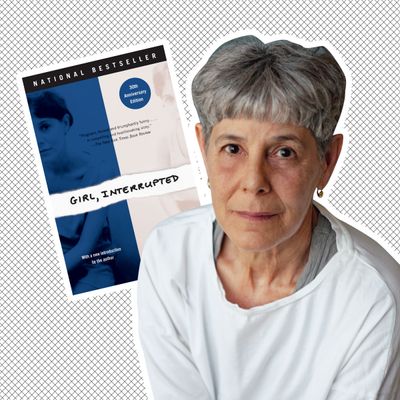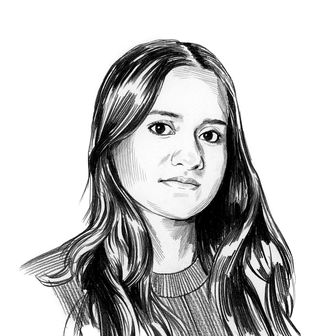
At the Massachusetts psychiatric hospital where Girl, Interrupted author Susanna Kaysen got treatment after a suicide attempt in the late 1960s, she encountered a burn victim who had set herself on fire. In the memoir, Kaysen wonders about the moment the woman lit the match, questioning whether she’d felt the same “inspiration” that Kaysen herself did before swallowing a bottle of painkillers, walking out into traffic, and collapsing. “Fifty aspirin is a lot of aspirin, but going onto the street and fainting is like putting the gun back in the drawer,” Kaysen wrote in her signature detached and exacting prose. “She lit the match.”
When Girl, Interrupted was first published in the summer of 1993, it broke open the floodgates of conversations around mental-illness stigmas and the emotional virulence of young womanhood, inspiring a flurry of memoirs and a 1999 film adaptation of the book starring Winona Ryder and Angelina Jolie. The book’s 30th-anniversary edition — out today from Penguin Random House — celebrates its enduring legacy with a new introduction from Kaysen herself. Now 74, she draws the curtain back on the creation of the book, originally intended as an anthropological look into her time in the hospital, and its unforeseen popularity. The memoir, Kaysen theorizes, may have “found so many readers” because of how much of the personal she withheld: “There was enough blank space in it for people to insert themselves,” she writes.
And for 30 years, readers have done just that. “It doesn’t really seem real; it feels impossible that it’s so long ago,” Kaysen tells the Cut. “I feel that way about all of existence, frankly — I just can’t imagine how time can be the way that it is.” In an era of therapy-speak and rising rates of depression in teenage girls, her work has perhaps defied time, remaining as sharply observed and comforting to anyone who needs it.
In the introduction to the anniversary edition, you write about how you tried to maintain an anthropological stance while writing the original memoir and therefore “left a lot out.” What exactly did you leave out? Would you do anything differently? What do you wish you’d put in?
I’m glad I left so much out. One shouldn’t say this about one’s own work, but I think it’s one of the good things about the book that I left so many particulars about myself out. I wouldn’t put anything more in. There’s a kind of blankness, to some extent, to my portrayal of myself. It leaves a lot of room.
That distance also allowed so many people struggling with mental health to insert themselves into the narrative. What has that been like for you, hearing their stories and knowing they’re being overlaid onto yours?
It’s paradoxical. The fact that I didn’t fill in a lot of stuff about my family myself — though you always reveal more than you think — gave people room to identify with it. On the other hand, when people told me, We’re just the same, you told my story, I would think, No, we’re not; no, I didn’t! I told my story. It was a strange thing — gratifying but also very confusing. I wouldn’t say that to people, because if they felt I told their story, fine!
As you note, the mental-health field and inpatient care has changed a lot since your time in the hospital. People don’t stay hospitalized for as long, and stigmas about mental illness are waning in some ways. What do you see as the most positive changes you’ve seen in the field of mental-health care today?
Do I have to see any?
Not at all.
I think there’s a little less stigma, but that has a bad side, which is that people tend now to medicalize themselves and to say, I have depression, when maybe they’re just sad. It’s good that people don’t feel it’s impossible to say sad feelings or angry feelings or just disturbed feelings as much as they used to. It’s better that people are more able to express themselves, but it quickly can lead to a pathology, rather than an acceptance of the variety of human emotions. There’s an American can-do attitude that can be bad for people, and I’m not sure it’s lessening. I have cancer now, and you’re supposed to have a good attitude. To hell with it. How are you supposed to have a good attitude? It would be cuckoo to have a good attitude. There’s something about that general tenor of American emotional life. I consider it a very American problem: the inability to tolerate unpleasant emotions. Some emotions are unpleasant, some experiences are unpleasant, some things are very sad, some things are very frustrating. And that’s okay. You can’t fix it. That’s the way life is.
I don’t know what’s improved. Though these long hospitalizations used to be standardized, stowing people away in state hospitals and forgetting about them — that wasn’t good for people. But there was a way in which, for some people, the hospital could be a refuge or a haven, and I don’t think that’s true anymore. If you’re a kind of wacky teenage girl who’s cutting herself, it isn’t easy to just go away and drop out of life for three or four months. You can’t do that. You can go for 15 days, and that’s not going to change your situation.
What, in your opinion, has become worse?
Access has gotten harder for people than it used to be. Insurance is a whole mess. People haven’t got the money for these things. Insurance won’t pay for these things. And many of [the hospitals] have been shuttered. There was the whole de-hospitalization push in the ’70s and ’80s, and people who really didn’t know how to live in the world anymore were just plopped out. How can you just say good-bye to somebody who you institutionalized for 20 years, who doesn’t know how to manage in the world because you locked that person up?
It’s a very confused way of handling the problem. And it’s easy to criticize. I’m not running a hospital. I’m not a policy-maker. I don’t know all the complications of trying to handle this stuff. It’s a big thorny mess. I don’t have any solutions. And then there’s all these drugs, many of which just didn’t exist when I was in the hospital. Who can say they help or they don’t? They help some people and they don’t help others. There’s an overreliance on them. When they weren’t there, you couldn’t rely on them. When I was in McLean, there wasn’t any Prozac. It was just a dream somebody had dreamed.
The CDC reports that teenage girls are reaching record levels of sadness, with one in three girls estimated to be contemplating suicide as of 2021 and three in five experiencing “persistent sadness.” What do you think of the current crisis?
I think perhaps people underestimate just how disruptive the pandemic has been. It isn’t over, but we’re pretending it’s over because we have to live with it the way it is now. But those two years were so incredibly upsetting for everybody. Even if you didn’t get sick yourself, even if you didn’t lose a family member or a close friend — and there’s very few people who didn’t — what happened to society was terrifying, especially if you were young. I’m not young anymore, and it terrified me. The end of the world was possible, or the dissolution of life as we know it. Being cut off from people is the worst thing you can do to a human being. It’s why solitary confinement is considered such a terrible thing to do to people. Most people probably weren’t in solitary confinement, most teenagers, but it probably felt like that to them. That undermined a lot of young people’s sense of what’s possible or good in life. I think that’s as much a factor accounting for the sadness as all the social-media stuff, which I don’t understand because I don’t participate in it, but I can see there’s something horrible about all that.
There’s also a lot of diagnoses and psychotherapy-speak casually thrown around, and young people using social media often self-diagnose (and often misdiagnose) themselves there. What do you think gets lost in that?
Part of what’s bad about this openness is the medicalization of everything. People are saying, I have clinical depression. Does it really help you to call it that? I don’t know. I think it makes it more scary. I don’t see where it gets you, exactly. But I think there’s a lot more of that, of being unable to just say, I’m miserable. Life hasn’t turned out the way I wanted or the way I thought it would be. I’m 19 and I never went to my high-school graduation.
Why do you think it’s more comfortable for people to rely on medical language?
It probably varies. There’s a certain safety in naming things; it closes off thought. It’s not accurate to say it absolves the person of responsibility, but it kind of does. If you look at a sad situation you’re in, let’s say you’re the 19-year-old who didn’t go to your high-school graduation because it was the middle of COVID and nobody was going anywhere, and you feel depressed and say you have clinical depression — suppose you didn’t go to that step and just said, Yes, I missed an important ritual that most people participate in in my culture, and I’ll never have it. That’s very sad. I have to accept that that’s what happened. I have a loss, and I have got to be sad, and I’ve got to say, that’s the loss, I can’t make it up, I have to continue with my life. How am I going to do that? Whereas, if you say, I missed my graduation, so I have clinical depression, you stop there. You’re absolved. I don’t have to do anything about it because that’s what I have, depression. I don’t have to contend with it.
This is the problem with self-diagnosis. Not that I think psychiatry fixed everything, because it didn’t. But if you were talking to a shrink, the shrink would probably just say what I just said: You have a right to be sad, but you must continue living. Retreating to a diagnosis can be a way of not engaging with it.
It’s bad, this label soup. “I have ADD, I have OCD, I’m depressed.” Come on! You’re a teenager. This is what it’s like. It’s terrible. That much, I remember.





